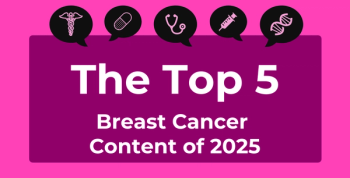
SOLAR-1 Trial in Metastatic Breast Cancer
The SOLAR-1 trial data in the second-line setting in metastatic breast cancer are examined as well as the use of alpelisib and everolimus.
Transcript
Hope S. Rugo, MD:The reason we want to test forPIK3CAmutations is because of the SOLAR-1 data and our use of alpelisib. Priyanka, tell us a little bit about the use of alpelisib in the SOLAR-1 trial. What did that study show?
Priyanka Sharma, MD:SOLAR-1 was a trial for women in the second-line setting after progression on the first-line aromatase inhibitor therapy, and it showed the benefit of adding a specific PI3K [phosphatidylinositol 3-kinase] inhibitor to a backbone of fulvestrant. There was improvement in progression-free survival that was clinically meaningful, almost a 6-month improvement. That led to the approval of the drug last year.
Now it's available for us to use in clinic, and that obviously has driven the clinical necessity to look for PI3 kinase mutations. In this trial, the benefit of alpelisib was noted primarily in patients who harbored a PI3 kinase mutation in the specified domain, and about 40% of the patients had a PI3 kinase mutation when tested on tumor tissue.
Hope S. Rugo, MD:It's an interesting question. The real question is what are we seeing in the population at large in terms ofPIK3CAmutations, but then what do you do with the patients who either don't have a mutation or they have already progressed or can't tolerate alpelisib for whatever reason? How are you using everolimus now, Tiffany?
Tiffany A. Traina, MD:It’s still one of the drugs in our armamentarium, and so it depends on what the toxicity and concern was, like you mentioned if somebody wasn't able to tolerate alpelisib. I’d want to be sure patients aren't having difficulty with pneumonitis as I'm thinking about using everolimus, but I still see it has a place. It just has moved down quite a bit in the lines of potential options for endocrine therapy partnered with exemestane.
There is evidence for partnering it also with tamoxifen even. Sometimes in someone who’s had a small level of progression but needs a change of therapy, has sequenced through all of our other available endocrine therapies and perhaps they’re PI3 kinase wild-type, I would see that as an option with the steroid rinse to make the mucositis more manageable, if you will, as an alternative to moving onto chemotherapy.
Hope S. Rugo, MD:Priyanka, where do you tend to use everolimus, and what's your preferred partner with everolimus?
Priyanka Sharma, MD:I agree with Tiffany that especially the patients who have a PI3 kinase mutation and cannot tolerate alpelisib maybe because of diarrhea, or a small proportion who develop significant rash, this is a useful drug. For patients who haven't had fulvestrant, obviously that makes for the most rational partner. I see a role in later lines of therapy as well combining with Aromasin [exemestane] or tamoxifen.
I agree with the pneumonitis aspect. Obviously, patients who have had pneumonitis with alpelisib are probably at higher risk for having it with everolimus, but diarrhea and rash sometimes are one of the reasons we can't give alpelisib. Also, our patients who have hemoglobin A1C [glycated hemoglobin] above the threshold that SOLAR-1 used or have uncontrolled diabetes.
Hope S. Rugo, MD:I think it's a great question. Claudine, when you give alpelisib to a patient with fulvestrant, how are you managing their blood testing and managing toxicity?
Claudine J. Isaacs, MD:Obviously it’s one of those drugs that makes us be better internists again, for some of us who are old and forgot some of this stuff. We need to manage and follow their glucose carefully on this and be monitoring their hemoglobin A1C, and I tend to follow the algorithm that's out there for what we should be doing in terms of metformin dosing and a variety of things by monitoring there carefully for that.
Hope S. Rugo, MD:It was interesting, we just presented data at ESMO [the European Society for Medical Oncology] in 2019 about the time course of toxicity with alpelisib on SOLAR-1. What we saw is that if you're going to be hyperglycemic, you usually peak in the first 15 days and the same with rash. We actually have encouraged people to use preventive antihistamines, and the non-sedating antihistamines seem to play a big role.
I've actually doubled the dose in the first week or so for patients, and we stopped seeing rash. It was interesting that when we were doing the phase 1 studies, we saw tons of rash, and then we stopped seeing it. I think this is something like the steroid mouthwash that we used for everolimus stomatitis, that we can really minimize that toxicity. For the hyperglycemia, it’s been interesting. I don’t know if any of you talk to patients. There are a lot of patients who have hemoglobin A1Cs that are slightly elevated. We know they are at higher risk. I’ve actually found the insulin-dependent diabetics easy because they just modify their insulin. But for the other patients, do you talk to them about a low carbohydrate-type diet? Tiffany?
Tiffany A. Traina, MD:We do. We check a baseline hemoglobin A1C and talk about generally having a low carb diet as well as having a finger stick monitoring, glucose monitoring. As Claudine mentioned, it's just been a new world and having to relearn diabetes management. It’s something we haven't had to do for a long time.
Hope S. Rugo, MD:By the time I get past metformin, I'm usually getting my endocrinologists involved, and I’m guessing most of you guys are too. But there are new classes of drugs that we learn about on the television that we may have some guidelines for recommending, and that will help us a little bit because our endocrinologists are also busy. So it's interesting. Then there's also some interest in combination therapies and how we're giving other alternative agents in the hormone receptor-positive setting. I don't know if you have any perspective on where we're going to go with this moving forward. Priyanka?
Priyanka Sharma, MD:Obviously, we've seen the efficacy of AKT inhibitors in this setting with fulvestrant, and capivasertib, which is in a phase 3 trial right now in the second-line setting after progression on first-line AI [aromatase inhibitor] therapy. For that trial, it’s enrolling regardless of PI3 kinase mutation status, so patients who don't have a mutation and are otherwise a good fit, we’re recommending that trial to patients. Among the second-line space, I see that as one of the other promises that hopefully will bear fruit.
Newsletter
Stay ahead of policy, cost, and value—subscribe to AJMC for expert insights at the intersection of clinical care and health economics.






































